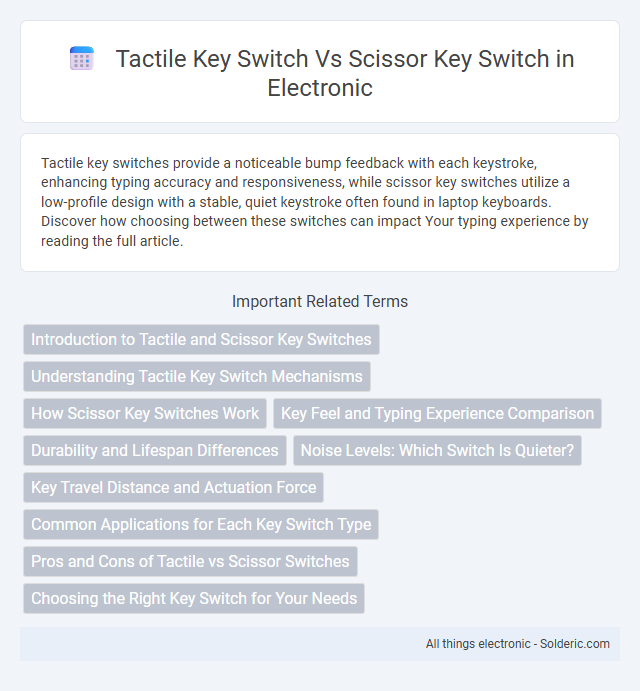Tactile key switches provide a noticeable bump feedback with each keystroke, enhancing typing accuracy and responsiveness, while scissor key switches utilize a low-profile design with a stable, quiet keystroke often found in laptop keyboards. Discover how choosing between these switches can impact Your typing experience by reading the full article.
Comparison Table
| Feature | Tactile Key Switch | Scissor Key Switch |
|---|---|---|
| Key Feel | Provides a tactile bump feedback on actuation | Soft, quiet key press with low travel distance |
| Travel Distance | Typically 2-4 mm | Short travel, usually around 1-2 mm |
| Key Stability | Moderate stability with individual key mechanism | High stability due to scissors-like mechanism |
| Durability | High durability, rated for millions of keystrokes | Moderate durability, less lifespan than mechanical switches |
| Noise Level | Moderate noise from tactile bump | Quieter, minimal sound on actuation |
| Common Usage | Mechanical keyboards and high-performance typing | Laptops, low-profile keyboards, and office use |
| Cost | Higher cost due to mechanical components | Lower cost, often integrated in budget-friendly keyboards |
Introduction to Tactile and Scissor Key Switches
Tactile key switches provide noticeable feedback with a bump when pressed, enhancing typing accuracy and responsiveness, ideal for users who prefer physical confirmation without audible clicks. Scissor key switches feature a low-profile design with a stable, quiet mechanism, commonly found in laptop keyboards, offering a comfortable and efficient typing experience. Your choice between tactile and scissor key switches depends on your preference for feedback intensity and keyboard form factor.
Understanding Tactile Key Switch Mechanisms
Tactile key switch mechanisms provide a noticeable bump feedback upon actuation, enhancing typing accuracy without requiring full press, which contrasts with the softer, quieter response of scissor key switches commonly found in laptops. These switches typically use a spring and slider design that creates resistance at the actuation point, improving user awareness of key registration. Understanding the tactile feedback and actuation force variations aids in selecting the best switch for ergonomic needs and typing performance.
How Scissor Key Switches Work
Scissor key switches use a mechanism where two plastic pieces interlock in a scissor-like fashion beneath each keycap, providing stability and a shorter travel distance compared to tactile key switches. This design enhances key responsiveness and reduces typing noise, making them ideal for laptop keyboards and slim peripherals. Your typing experience benefits from a more precise actuation and consistent keypress, especially during fast or prolonged use.
Key Feel and Typing Experience Comparison
Tactile key switches provide a noticeable bump when pressed, delivering clear feedback that enhances typing accuracy and speed. Scissor key switches offer a softer, quieter typing experience with shorter key travel, making them ideal for portable keyboards and laptops. Your choice depends on whether you prefer precise tactile feedback or a quieter, low-profile typing sensation.
Durability and Lifespan Differences
Tactile key switches typically offer higher durability, often rated for 50 million to 70 million keystrokes, making them ideal for heavy typists or gamers seeking longevity. Scissor key switches, commonly found in laptops, have a shorter lifespan, generally around 5 million to 10 million keystrokes, but provide a more stable and quiet typing experience. Understanding these durability differences helps you choose the best switch type for your device's expected usage and lifespan requirements.
Noise Levels: Which Switch Is Quieter?
Tactile key switches produce a distinctive click sound that can be noticeable in quiet environments, whereas scissor key switches are engineered for minimal noise due to their low travel distance and rubber dome mechanism. Your workspace will benefit from scissor switches if you prioritize a quieter typing experience, as they generally emit less sound compared to louder tactile switches. This makes scissor key switches ideal for shared offices or noise-sensitive settings where reducing keyboard noise is essential.
Key Travel Distance and Actuation Force
Tactile key switches typically have a longer key travel distance, ranging from 2.0mm to 4.0mm, with an actuation force between 45g and 60g, providing a noticeable bump feedback ideal for typing precision. Scissor key switches, commonly found in laptops, feature a shorter key travel distance around 1.5mm to 2.0mm and require less actuation force, usually between 40g and 50g, enabling faster key presses with reduced finger fatigue. The differences in travel distance and actuation force influence typing comfort and speed, making tactile switches preferred for desktop mechanical keyboards while scissor switches offer slim designs optimized for portability.
Common Applications for Each Key Switch Type
Tactile key switches are commonly used in mechanical keyboards favored by gamers and typists who require precise feedback and durability during extended use. Scissor key switches are prevalent in laptop keyboards and low-profile desktop keyboards, offering a quiet, responsive typing experience ideal for office environments and mobile use. Your choice between tactile and scissor key switches should consider these applications to match your performance needs and typing comfort.
Pros and Cons of Tactile vs Scissor Switches
Tactile key switches offer a noticeable bump with each keypress, enhancing typing accuracy and feedback, making them ideal for users who prefer a more responsive feel. However, they tend to be noisier and may cause finger fatigue during extended use. Scissor switches deliver quieter, shorter key travel that suits slim keyboards and laptops, but they lack the pronounced tactile feedback, potentially reducing typing precision for some users.
Choosing the Right Key Switch for Your Needs
Tactile key switches provide a noticeable bump with each keystroke, offering satisfying feedback ideal for typists who value precision and responsiveness. Scissor key switches, commonly found in laptop keyboards, feature a low-profile design with a stable and quiet key press suited for compact layouts and office environments. Your choice between tactile and scissor switches should depend on whether you prioritize typing comfort and feedback or a slim, quiet keyboard experience.
tactile key switch vs scissor key switch Infographic

 solderic.com
solderic.com